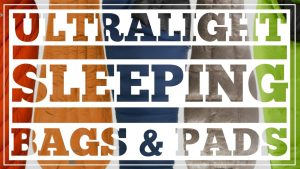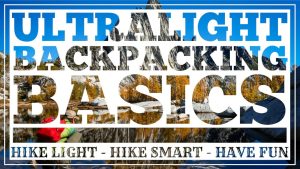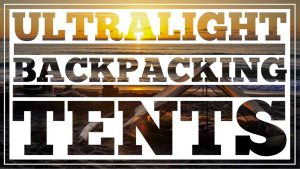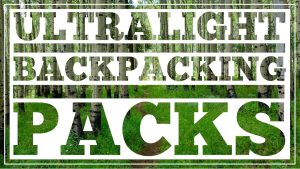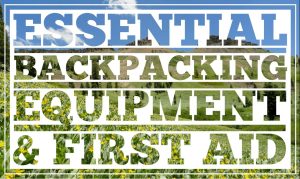Ultralight Backpacking Stoves – Episode 6
Some of the links on this page are affiliate links
Ultralight Backpacking Stoves
Eating a warm meal at the end of a long day on the trail can be one of the best parts of your day, and with lightweight cooking options, it doesn’t have to break your back while you hike either!
Many ultralight backpacking stoves only weigh a few ounces and will be well worth the small investment. The most common lightweight stoves options are canister stoves, alcohol stoves, wood stoves, and solid fuel stoves.
Once you’ve considered the pros and cons of each and decided which type will work best for your treks, check out our Stove Guide to find the best brands and models.
Cooking Gear
Most lightweight backpackers don’t really cook food on the trail as much as they rehydrate. If it’s going to take more effort than boiling water and pouring it into a bag, it’s generally seen as too much work.
Because trail cooking is so simple, you’ll only need to bring a minimal set of tools for cooking your meals. All you’ll really need is:
- Lightweight stove
- Cook pot
- Small camp cup
- Trail spoon
Titanium pots tend to be the lightest, but they’re also the most expensive. Plastic trail cups are lightweight and affordable. Trail spoons come in a variety of plastic and metal options which will both be very light. Just make sure to pick a spoon that will be tough enough for the trail. Otherwise you’re likely to ugly-face cry when your spoon handle cracks off in your peanut butter jar.
Canister Stoves – Liquified Gas
Liquified gas stoves are a common option among lightweight backpackers and they’re generally considered to be the easiest stoves to use as well. Simply screw your stove into a liquified gas canister and light it up for a quick meal.
Canister Stove Pros:
- Easy to use
- Convenient
- Quick
- Burn clean
- Work well at altitude
Canister Stoves Cons:
- More expensive
- Slightly heavier
- Not great in cold weather
- Cost of fuel over time
- Hard to find fuel in small trail towns
- Canisters are non-refillable
Alcohol Stoves
Alcohol stoves are among the lightest and cheapest stove options. For that reason, they’re a popular option among thru-hikers and ultralight backpackers.
To use an alcohol stove, all you have to do is pour denatured alcohol or Heet (the yellow bottle) into your stove and light it up. Your stove will then stay lit until all the fuel is burned up.
Because alcohol stoves are most often made of tin or aluminum, they will generally weigh under an ounce. Also, most gas stations carry Heet, so it’s usually very easy to resupply fuel for your stove.
Alcohol Stove Pros:
- Light
- Cheap
- Burn clean
- Burn quiet
- Easy to resupply fuel
- Can make yourself
Alcohol Stove Cons:
- More dangerous
- Slower cook times
- Affected by wind (use a windscreen)
- Touchy in cold weather
- Not as convenient
Wood Stoves
Wood stoves are another option that is becoming more popular among lightweight backpackers. Wood stoves create an efficient system for using fire to cook your trail meals. It’s the same concept as cooking over a campfire, but with a wood stove, it’ll be much easier to do.
Wood stoves tend to be heavier than other stoves, but there are some good lightweight options out there. Also, it’s important to note that your fuel weight will be near zero, because you’ll be using natural fuel from your surroundings.
If you’re someone that likes to cook, rather than rehydrate, a wood stove might be a good option for you. With a wood stove, you’ll be able to keep a flame going for a longer period of time without having to worry about fuel usage. You’ll also be able to loosely control the temperature of your stove by adding more or less fuel to your fire.
Wood Stove Pros:
- No fuel weight
- No fuel cost
- More cooking control
- Fire is fun
Wood Stove Cons:
- Slower cook times
- Not as convenient
- Takes practice
- Affected by wind
- Blackens your pot
- Wet weather can affect fuel
Esbit Stoves – Solid Fuel
Esbit stoves are probably the lightest cooking option out there. To cook using Esbit, all you have to do is bring fuel tabs and a stand out on the trail. Simply crack open the Esbit container, light it on fire, and place it on your stove. The Esbit tab will burn for about 10-12 minutes, giving you plenty of heat for a simple trail meal.
Esbit stove Pros:
- Very light
- Convenient
- Easy to use
- Work well most everywhere
Esbit Stove Cons:
- Slow cook times
- Affected by wind (use windscreen)
- Cost of fuel over time
- Hard to find in small trail towns
- Residue on the bottom of your pot
Stoveless Option
If you want to go really light, you could always consider backpacking without a stove at all. Lots of lightweight backpackers go stoveless and end up enjoying it a lot.
If you do go stoveless, you’ll probably increase your food weight a bit because you’ll be carrying less dehydrated meals. When all said and done, going stoveless is probably the lightest way to pack, but not by a crazy amount.
Summary
The convenience of canister stoves is pretty tough to beat, especially for shorter trips. If you’re looking to pack light for a long trail, an alcohol stove will be cheap, light, and easy to resupply. If you’re looking for a stove that will provide some style and adventure to your trip, take out a wood stove. Or if you’re a true minimalist at heart, consider going stoveless or using an Esbit stove.
Once you’ve considered the pros and cons of each option and decided which type of stove will work best for your treks, check out our Stove Guide to find the best brands and models.
Hike light, hike smart, and have fun.
POPULAR CLEVERHIKER CONTENT
- BEST BACKPACKING TENTS
- BEST LIGHTWEIGHT BACKPACKS
- BEST SLEEPING BAGS
- TOP GEAR PICKS
- 12 BEGINNER BACKPACKING BLUNDERS
- 5 REASONS TO DITCH YOUR HIKING BOOTS
- BEST BACKPACKING STOVES
- BEST SLEEPING PADS
- BEST HAMMOCKS
- 21 TIPS FOR THE FIRST TIME THRU-HIKER
- LIGHTWEIGHT GEAR TUTORIAL VIDEOS
- ESSENTIAL TRAIL SKILLS TUTORIAL VIDEOS
MORE EPISODES IN THIS SERIES
View all